Jade River: A History of the Mahurangi
Ronald H LockerFirst published 2001. Published online 2014–. This online edition is a work in progress…
Pages 72–76in first and second, printed, editions
Founder of Mahurangi tidehead town
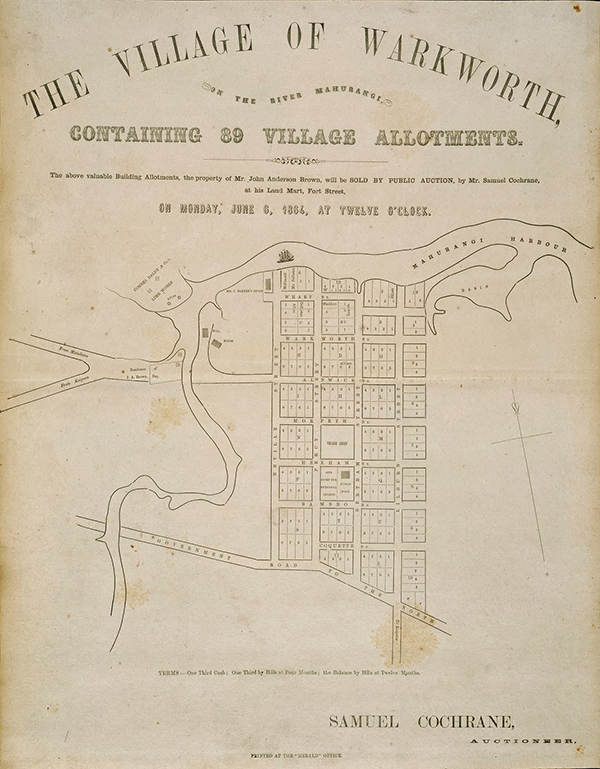
Mahurangi Harbour Tidehead Town: Topographically preordained, at the Mahurangi Harbour tidehead, the town was heralded by an undershot-water-wheel-powered sawmill harnessing the modest head available from Mill Stream at its confluence with the Mahurangi. What wasn’t preordained was the obliteration of the area’s Māori name, Puhinui, or the utterly utilitarian plan of ‘The Village of Warkworth’, in angular contrast to the organic layout of its namesake on the River Coquet, Northumberland. image Heritage et AL
Was published 2001: Warkworth. Aotearoa added, to unsubtly emphasise the incongruity of imposed European placenamesarkworth, Aotearoa, had its beginnings in a water-powered sawmill, the first in the Mahurangi.
Its proprietor, John Anderson Brown, thus became successor in the local timber industry to his near namesake, Gordon Browne. Unlike his predecessor he was no transient; there, at the tideheadas published in 2001: head of the tide, he lived out a productive life, and saw his grander designs for the place largely fulfilled.
Brown was born in Newcastle-on-Tyne in 1801. It is not certain whether he ever lived at nearby Warkworth, but he would have known it well as an ancestral place. His grandfather, William Brown (1754–1838), was its schoolmaster for 52 years. John’s father must have grown up there. Warkworth is a Northumbrian village, set splendidly on a loop of the River CoquetThe curious misspelling of River Coquet that has the street name in Mahurangi rendered Coquette, also infected the 2001 hardcopy editions. The coquet of River Coquet, rather than referring to flirtatiousness, probably stems from Roman nomenclature relating to red-coloured river stones., and crowned by a castle. It lies almost on the coast, midway between Newcastle and Berwick-on-Tweed.
In 1824, at 23, John emigrated to Tasmania on the schooner Industry. He worked there as builder and architect, and held:
…several lucrative Government appointments.
He married and had a son, John Reid Brown in 1833, and a daughter Amelia in 1836. (It may be inferred that his wife was a Reid). After his wife’s death he emigrated to New Zealand, leaving his children in care. The claim that he built the first Anglican church at the Bay of Islands is incorrect, since Christ Church was built at Kororāreka in 1835 by Gilbert Mair, but he may have helped, or worked on a later church in that region.
Brown arrived in Auckland in 1840 and set up in business. The New Zealand Gazette shows that he acquired several town lots in 1841. An advertisement in this journal on 29 September 1841, advises of the winding up of J.A. Brown & Co., and asking all persons with debts or claims on the firm to settle. According to Pulham:
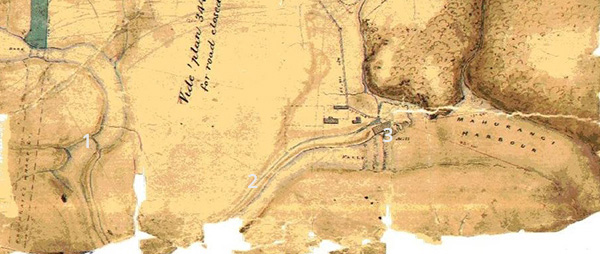
Weir and Race to the Mill: A marvellous 2018 find by Auckland Council heritage advisor Robert Brassey, this 1856 map clearly shows the upstream weir, at 1.) and the water race 2.) connecting to the sawmill at 3.). The nearly 500-metre long millrace is surprising, considering that, with little gain in elevation, it could presumably have not provided a volume and velocity greatly exceeding that available from a weir and race built immediately adjacent the mill. image Auckland Council
…he commenced store keeping under the style of Dalzile and Co. Through some fault of the senior partner, the firm collapsed and Mr Brown turned his attention to the marketing of timber.
The police censuses of Auckland, 1842–5, show that there was a firm Dalzell & Co. in Queen Street in 1842, but not thereafter. Neither Brown nor Dalziell appear in any year as residents. It seems Brown may have owned the premises: in 1845 he, then described as a sawyer, was still letting premises in Queen Street to a merchant.
The need for sawn timber in the new town was obvious enough, and Brown saw it as an avenue of profit. With two companions and a Māori crew, he set out northwards in a whaleboat, looking for a place to establish a sawmill. Rowing up the Mahurangi as far as one can go, they came to the place where the river cascades into the tide. Brown decided it was a suitable site for a watermill, and the timber supply left nothing to be desired. A timber-cutting license could be had for £5 a year. Brown and Captain Kasper appear to have been the first to exploit the timber at the tideheadas published in 2001: head of the River on this basis. Brown’s companions were less impressed and “drew out.” In 1844 his brother:
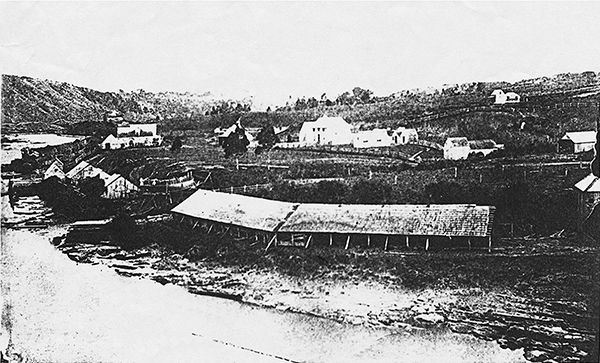
Early Image: One of the earliest photographs of Mahurangi’s tidehead town, said to be pre-1880s. It is suggested that the riverside building in the foreground is a timber-drying shed, in which case timber was probably loaded out via Kapanui Stream, at the shed’s downstream end. Regardless, it is likely that the operation was subsequent to that of John Anderson Brown, whose sawmill, established in the early 1840s, was farther upstream, between the Mahurangi River and Mill Stream. Two decades earlier, another timber trader, Gordon Davies Browne-with-an-e established the first European settlement in the Auckland region, downstream in the Mahurangi Harbour. image Locker family archive
…who was a first rate mechanic came out and joined him, but being of a restless disposition left again as soon as the mill was finished.
Together they harnessed the Mill Streamsee Robert Brassey comment below, building the dam, race and mill, which stood on the left bank just below the present bridge. Ten years later, in the New Zealand Gazette of 14 March 1853, p 271, a traveller from Sydney described the mill:
—two considerable fresh water streams unite, both emptying their currents over natural embankments of free-stone. On the delta thus formed, Mr John Anderson Brown, formerly of Hobart Town, has erected a sawing mill on the American principle. The machinery, as far as is practicable, is made of wood; and it may be noteworthy as a test of durability, that one of the bushes, upon which the spindle of the undershot water-wheel revolves, is of Van Dieman’s Land tea-tree. It has been in constant use for the last eight or nine years, during which period it has not worn one sixteenth of an inch. Mr Brown’s mill is a remarkably simple one, but from being worked by an undershot wheel, the supply of water required is excessive, although Mr Brown has expended much money and ingenuity in adjusting his machinery.
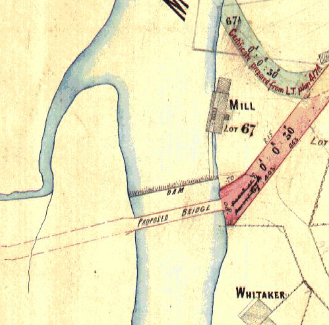
Short Swift Millrace: It is potentially instructive that the length of the millrace from weir to wheel of the flour mill built by Palmer and Jakins, in 1866–7, was a fraction of that—possibly little more than 20 metres—of the energy-sapping 500-metre-long race that fed Brown’s timber mill, earlier. image Auckland Council
This suggests that the mill machinery may have been purchased in Hobart, and perhaps brought out by his brother (S.V. Martin also imported his mill from Australia). It appears the mill began sawing late in 1844. In the 1845 Police Census of Auckland, the mill is described as the “Mauranghi Sawing Station”, where 30 males and five females lived. The only other population recorded by the census for the area in 1845 was 35 males on Kawau. In 1844 only 21 males and 21 females had been recorded for “Maurangi and Matakaura” (Matakana).
The manager of the mill was John Chandler, an Englishman who came with experience in the American lumber industry, which in those days would have meant the north Atlantic seaboard. He was:
well acquainted with the method of getting timber out by building dams. Nearly all the timber had to be got out in this way.
In view of Chandler’s subsequent career as a millwright in the Waikato, and the mention above of American design, he may well have had a hand in the erection of the mill. Pulham described the scene:
A large and flourishing business was carried on at this time, and a very busy and animated scene there was all about the bank of the river. Owner, manager and workmen all lived in raupō houses close by. One day they got a great scare, Mr Brown’s house catching fire by some accident. Of course all the men rushed to put it out and might have succeeded but for the cry, ‘There’s a keg of powder in the house!’, which sent them all scrambling down the bank faster than they came up; so the fire had all its own way; and had it not been for this scare a great many things could have been saved but it was all lost. There was no powder in the house: it was all in a little shed some distance away. But with the great natural energy of Mr Chandler a timber house was built—
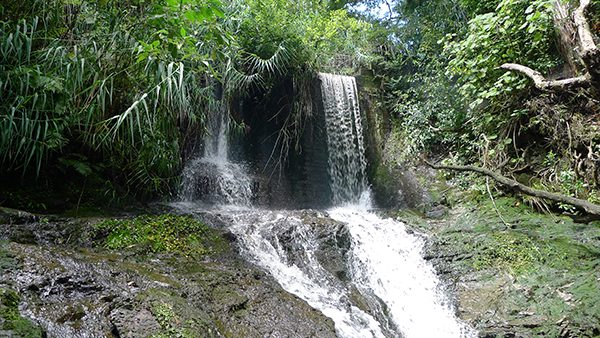
Seriously Weir-ed Warkworth: ‘By the way do you know about the Wilsons Cement Works dam (1913) on the second side-stream downstream from the Elizabeth Street Bridge?—it’s just below the Sandspit Road, and seems to be owned by the council.’ A 1913 Rodney and Otamatea Times article says that the stream was sometimes called by old residents Ody’s Creek. image Robert Brassey
Chandler’s wife Charlotte was an American, and it seems, used to life in the woods. She was housekeeper to Brown, and shot pigeons for the pot as needed.
It was from a few peach stones that Mrs Chandler had brought from America that we got our first peaches. Many of the oldest settlers will remember the trees that grew near Mr Brown’s house, and how delicious the old gentleman’s peaches were — and how useful to plant in some odd corner.
Those were the days of goats in Mahurangi, and Mr Brown had a goodly number. His goat shed was about 100 feet long and three feet high reaching up to where the police station now stands. The goats were shut up each night and milked in the morning, some of them giving as much as half a bucket of milk.
The Chandlers did not stay long, but moved to the Waikato, where John built flour mills for the mission stations up to the time of the Waikato War, when he became pilot to the gunboats on the river. His life in the Waikato and subsequently on Motuora is told later.
Brown’s only right to tenure was his timber licence. When the Mahurangi was surveyed and put on the market in 1853, he hastened, like others, to exchange squatter status for the security of ownership. He was a shrewd enough businessman to see the potential of this easy land at the head of tidal navigation. On 15 November 1853 he purchased 153 acres of the land lying between the Mahurangi River and the proposed North Road for £69. Another 81 adjacent acres were bought in his daughter’s name. A grand scheme was already taking shape in his mind. Just six months later he was advertising town lots. Land agents of the last century excelled those of today in hyperbole. The advertisement in the New Zealander of 27 May 1854, described the beautiful district of Mahurangi, 24 miles from Auckland, with:
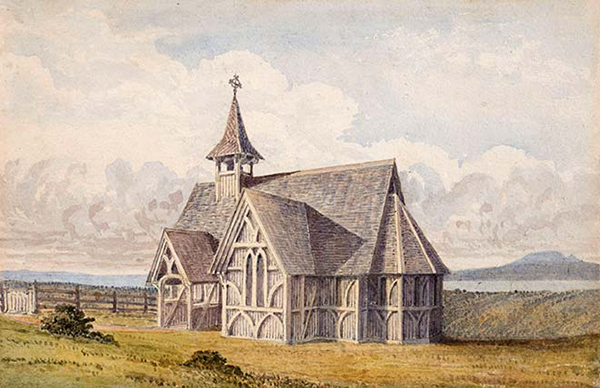
Brown Barn v. Thatcher Elegance: Mahurangi came close to hosting a Frederick Thatcher colonial Gothic masterpiece, but intransigence by John Brown, who had gifted land for an Anglican church, insisting that his own design—described by John Frederic Lloyd, Archdeacon of Waitematā as the barn plan—saw the opportunity for grandness spurned. A Mahurangi Thatcher, however, would not have featured the rot-prone exterior frame featured on his much earlier 1846 St John’s College Chapel, pictured here, but would have brought the beauty of that detail inside a more weatherproof board-and-batten clad structure. watercolour John Kinder | Auckland Art Gallery Toi o Tāmaki
its fertile and majestically timbered lands; its splendid Agricultural and Grazing capabilities; its fine Harbour; its rich possession of Nature’s scenic grandeur; its numerous respectable settlers; and indeed its almost innumerable recommendations
and held it likely to:
take its position as one of the most flourishing towns in the province. The township is situated at the head of the river Mahurangi at the spot originally chosen by the Surveyor-General for the township of that name. It has now been named “WARKWORTH”.
There followed a description of its gentle sheltered slopes, the proposed new road links to the interior, the layout of streets, the adequate provision for public reserves, places of worship, schools, burial grounds and wharves. Quarter acre lots were offered at £6–15 each. As in the case of the Mahurangi village, there was no great rush to buy. The first straggle of houses continued to be known for a time as Brown’s Mill, but it was not long before the new town became established and began its long march towards prosperity.
It seems that Brown also established the first flour mill in the town. During the incident of the Māori escapees from Kawau, a foraging raid was made on the mill (11 October 1864). The site of the incident was unequivocally described as John Anderson Brown’s mill at Warkworth. Whether this was on the same site as Palmer’s later mill on the right bank is unclear. Palmer was in business by 1868, as shown by an account of robberies in Warkworth including two bags of flour from Mr Palmer’s mill (New Zealand Herald, 4 January 1868). An advertisement of 3 January gave notice that W. Hurst of Queen Street, Auckland:
…had made arrangements for the entire sale of production of the Mahurangi Flour Mills.
This mill used imported wheat and had a short working life.
Brown became a father figure in his town: its first postmaster (1859) and constable, chairman of the first Mahurangi Highway Board (1863), leader of a deputation to the Governor demanding protection from the escaped prisoners from Kawau (1864), etc. His sawmill continued to run for at least twenty years, since a visitor mentioned it in 1864.
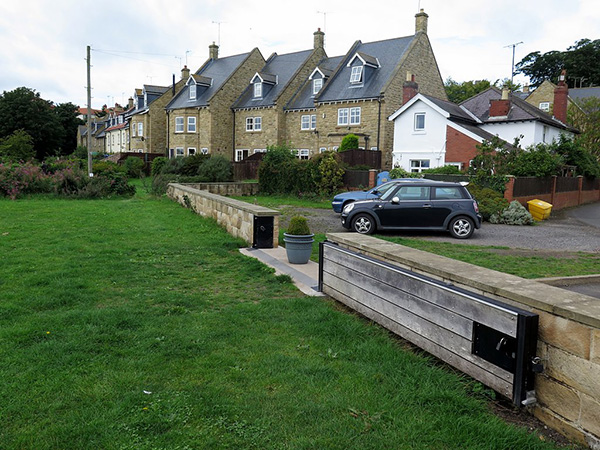
World’s Warkworths and Sea-Level Rise: The World’s five Warkworths, including the two in England, are all vulnerable to global-warming-exacerbated flooding, but those in the Mahurangi and Northumberland are also immediately vulnerable to anthropogenic sea-level rise. Here, beside the Coquet River, the Coquet Cottages enjoy respite temporarily provided by the £350 000 floodwall and floodgate, constructed a year after a tidal surge hit the Northumberland Coast on 5 December 2013. The ‘highest absolute levels’—6.02 metres—of the storm surge were experienced farther south, on the Lincolnshire Coast. image Geograph
He was a devoted Anglican, and about 1860 offered a site of three acres for a church. A number of settlers had already expressed willingness to support one. His offer was repeated to Bishop Selwyn when he visited in 1862. Brown, no doubt feeling qualified by his experience as architect and builder, forwarded a plan for the building to Auckland. A local building committee was formed, but there was no action. In 1866 two plans for the Warkworth church were submitted to the Standing Committee in Auckland: one Brown’s, the other by the gifted prelate/architect Frederick Thatcher (who left his elegant mark in both Auckland and Wellington). The committee had no difficulty in making a choice, but Archdeacon Lloyd, after consulting in Warkworth, reported sadly to the bishop:
I am afraid we shall have to adopt the barn plan — old Mr Brown is very obstinate and if we were to go against him it would create a division in the place — I did all I could to get Thatcher’s plan adopted. Mr Brown was the only refractory person. I thought I had succeeded but he returned to his own devices — I succeeded however in getting some slight modification of the barn plan adopted.
This stubbornness wasn’t a problem much longer: Brown died two years later, long before the church was built. In the interim, at least two other plans had appeared. The plan finally adopted seems to have been that of the builder, Claydon. Christ Church was consecrated on Sunday 30 April 1876 by Bishop Cowie.
On that day the father of Warkworth slumbered close by, in the churchyard he had given. John Brown had died at his home of paralysis—presumably a stroke—on 2 July 1867. He was not really an old man at 66.
The attractive and lively town of today is his living monument.

Was Brown’s timber mill powered by Mill Stream or by the Mahurangi River? In 1860 there was a dam across the Mahurangi River about 500 metres upstream from the mill. There is still in existence a water race from the dam site almost to mill site along the north side of the river (the bottom part has been obliterated). An 1878 plan shows another dam, annotated ‘old mill dam’, farther up the Mahurangi River.
I have now found an 1856 plan which shows the mill and buildings, water race and dam, and confirms that the race diverted water from the Mahurangi River.
That is a fantastic find Robert!—I would love to publish here, if that is acceptable.
Much of the earlier history of John Anderson Brown seems very vague. My 2x great grandfather was Richard Pescod Brown the youngest brother of John Anderson Brown. I have extensively researched my 3x great grandfather’s family and can add much more to your records if you so wish.